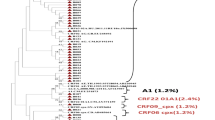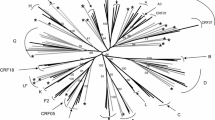Abstract
Kemerovo Oblast (KO) has had the highest rate of HIV spread in Russia since 2011. The aim of this work was to study the genetic variation of HIV-1 in Kemerovo Oblast. Blood was sampled from a total of 91 HIV-positive antiretroviral-therapy-naïve individuals in 2013 (38) and 2015 (53). HIV-1 subtypes, pol gene drug resistance mutations, and viral tropism were analyzed. In 2013–2015, the prevalence of HIV-1 subtype A decreased in KO from 60.5 to 7.5 %. The samples collected in 2015 from the patients with newly diagnosed HIV demonstrate the current dominance of HIV-1 CRF63_02A1 (71.7 %) and HIV-1 URF63_A1 (20.8 %), their parental viruses being CRF63_02A1 and subtype A. The initially predominant genetic variant, HIV-1 subtype A, was replaced in KO. An unusually high incidence of HIV-1 unique recombinant forms is probably the result of HIV-1 CRF63_02A1 introduction in the group of injection drug users with the initial HIV-1 subtype A infection and the practice of risky behavior that promotes reinfection. HIV-1 CRF63_02A1, which recently emerged in Siberia, and its recombinant forms have an ever-increasing impact on the current HIV epidemic in Russia, making urgent the need for in-depth study of this HIV-1 genetic variant.






Similar content being viewed by others
References
Global AIDS Update, UNAIDS report (2016)
UNAIDS “The Gap Report” (2014)
Online database of Russian Federal State Statistics Service (2016) Number of permanent residents of Kemerovo Oblast on 01.01.2015. http://cbsd.gks.ru/. Accessed 15 July 2016
Kolomeyets AN, Dovgopoliuk YS, Sergeeva IV (2011) [in Russian] Drug-resistant HIV-1 prevalence in Siberian Federal Region. HIV Infect Immune Disorders 3(4):51–55
Thomson MM, De Parga EV, Vinogradova A, Sierra M, Yakovlev A, Rakhmanova A, Delgado E, Casado G, Munoz M, Carmona R (2007) New insights into the origin of the HIV type 1 subtype A epidemic in former Soviet Union’s countries derived from sequence analyses of preepidemically transmitted viruses. AIDS Res Human Retrovir 23(12):1599–1604
Fernandez-Garcia A, Revilla A, Vazquez-de Parga E, Vinogradova A, Rakhmanova A, Karamov E, Carrera C, Delgado E, Perez-Alvarez L, Najera R (2012) The analysis of near full-length genome sequences of HIV type 1 subtype A viruses from Russia supports the monophyly of major intrasubtype clusters. AIDS Res Human Retrovir 28(10):1340–1343
Bogachev VV, Totmenin AV, Baryshev PB, Mescheryakova YV, Chernousova NY, Gashnikova NM (2012) [in Russian] Molecular and genetic characteristics of HIV-1 variants subtypes A and B isolated in Novosibirsk Oblast area. J Microbiol Epidemiol Immunobiol [Russian] 6:45–52
Gashnikova NM, Safronov PF, Nikonorova YV, Unagaeva NV, Lapteva TA, Bogachev VV, Chernousova NY (2011) [in Russian] Properties of CRF02_AG HIV-1 isolates circulating in the Novosibirsk Oblast area. J Microbiol Epidemiol Immunobiol [Russian] 3:38–43
Baryshev PB, Bogachev VV, Gashnikova NM (2012) Genetic characterization of an isolate of HIV type 1 AG recombinant form circulating in Siberia, Russia. Arch Virol 157(12):2335–2341
Baryshev PB, Bogachev VV, Gashnikova NM (2014) HIV-1 genetic diversity in Russia: CRF63_02A1, a new HIV type 1 genetic variant spreading in Siberia. AIDS Res Human Retrovir 30(6):592–597
Gashnikova NM, Bogachev VV, Baryshev PB, Totmenin AV, Gashnikova MP, Kazachinskaya AG, Ismailova TN, Stepanova SA, Chernov AS, Mikheev VN (2015) A rapid expansion of HIV-1 CRF63_02A1 among newly diagnosed HIV-infected individuals in the Tomsk region, Russia. AIDS Res Human Retrovir 31(4):456–460
Thompson JD, Gibson TJ, Fdr Plewniak, Fo Jeanmougin, Higgins DG (1997) The CLUSTAL_X windows interface: flexible strategies for multiple sequence alignment aided by quality analysis tools. Nucleic Acids Res 25(24):4876–4882
Hall TA (1999) BioEdit: a user-friendly biological sequence alignment editor and analysis program for Windows 95/98/NT. In: Nucleic acids symposium series, pp 95–98
Tamura K, Stecher G, Peterson D, Filipski A, Kumar S (2013) MEGA6: molecular evolutionary genetics analysis version 6.0. Mol Biol Evol 30(12):2725–2729
Lole KS, Bollinger RC, Paranjape RS, Gadkari D, Kulkarni SS, Novak NG, Ingersoll R, Sheppard HW, Ray SC (1999) Full-length human immunodeficiency virus type 1 genomes from subtype C-infected seroconverters in India, with evidence of intersubtype recombination. J Virol 73(1):152–160
Bennett DE, Camacho RJ, Otelea D, Kuritzkes DR, Fleury H, Kiuchi M, Heneine W, Kantor R, Jordan MR, Schapiro JM (2009) Drug resistance mutations for surveillance of transmitted HIV-1 drug-resistance: 2009 update. PloS One 4(3):e4724
Low AJ, Swenson LC, Harrigan PR (2007) HIV coreceptor phenotyping in the clinical setting. AIDS Rev 10(3):143–151
Tebit DM, Nankya I, Arts EJ, Gao Y (2007) HIV diversity, recombination and disease progression: how does fitness “fit” into the puzzle. AIDS Rev 9(2):75–87
Najera R, Delgado E, Perez-Alvarez L, Thomson MM (2002) Genetic recombination and its role in the development of the HIV-1 pandemic. AIDS 16:S3–S16
Lau KA, Wong JJL (2013) Current trends of HIV recombination worldwide. Infect Dis Rep 5(1S):4
Leoz M, Chaix M-L, Delaugerre C, Rivoisy C, Meyer L, Rouzioux C, Simon F, Plantier J-C (2011) Circulation of multiple patterns of unique recombinant forms B/CRF02_AG in France: precursor signs of the emergence of an upcoming CRF B/02. Aids 25(11):1371–1377
Giuliani M, Santoro MM, Lo Presti A, Cella E, Scognamiglio P, Lai A, Latini A, Fabeni L, Gori C, Pinnetti C (2013) Circulation of HIV-1 CRF02_AG among MSM population in central Italy: a molecular epidemiology-based study. BioMed Res Int
Mir D, Jung M, Delatorre E, Vidal N, Peeters M, Bello G (2016) Phylodynamics of the major HIV-1 CRF02_AG African lineages and its global dissemination. Infect Genet Evol
Delatorre E, Velasco-De-Castro CA, Pilotto JH, Couto-Fernandez JC, Bello G, Morgado MG (2015) Short communication: reassessing the origin of the HIV-1 CRF02_AG lineages circulating in Brazil. AIDS Res Human Retrovir 31(12):1230–1237
Laga V, Lapovok I, Kazennova E, Ismailova A, Beisheeva N, Asybalieva N, Glushchenko N, Bobkova M (2015) The genetic variability of HIV-1 in Kyrgyzstan: the spread of CRF02_AG and subtype A1 recombinants. J HIV AIDS 1(2)
Kazennova E, Laga V, Lapovok I, Glushchenko N, Neshumaev D, Vasilyev A, Bobkova M (2014) HIV-1 genetic variants in the Russian Far East. AIDS Res Human Retrovir 30(8):742–752
Lapovok I, Kazennova E, Laga V, Vasilyev A, Utegenova A, Abishev A, Dzissyuk N, Tukeev M, Bobkova M (2014) Short communication: molecular epidemiology of HIV type 1 infection in Kazakhstan: CRF02_AG prevalence is increasing in the southeastern provinces. AIDS Res Human Retrovir 30(8):769–774
Tongo M, Martin DP, Zembe L, Mpoudi-Ngole E, Williamson C, Burgers WA (2013) Characterization of HIV-1 gag and nef in Cameroon: further evidence of extreme diversity at the origin of the HIV-1 group M epidemic. Virol J 10(1):1
Esbjornsson J, Mansson F, Martinez-Arias W, Vincic E, Biague AJ, da Silva ZJ, Fenyo EM, Norrgren H, Medstrand P (2010) Frequent CXCR4 tropism of HIV-1 subtype A and CRF02_AG during late-stage disease-indication of an evolving epidemic in West Africa. Retrovirology 7 (1):1
Acknowledgments
The work was supported by the Russian Foundation for Basic Research (Research Project No. 16-15-10238). We thank all medical staff of the Kemerovo Regional Center for Prevention and Control of AIDS and Infectious Diseases for their assistance in sampling.
Author information
Authors and Affiliations
Corresponding author
Ethics declarations
Conflict of interest
The authors declare that they have no conflict of interest.
Rights and permissions
About this article
Cite this article
Gashnikova, N.M., Zyryanova, D.P., Astakhova, E.M. et al. Predominance of CRF63_02A1 and multiple patterns of unique recombinant forms of CRF63_A1 among individuals with newly diagnosed HIV-1 infection in Kemerovo Oblast, Russia. Arch Virol 162, 379–390 (2017). https://doi.org/10.1007/s00705-016-3120-4
Received:
Accepted:
Published:
Issue Date:
DOI: https://doi.org/10.1007/s00705-016-3120-4




